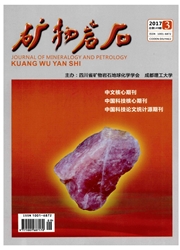

 中文摘要:
中文摘要:
庐枞地区(庐江、枞阳)在中生代发育有两个岩石学上重要的组合,一组为庐枞盆地橄榄安粗质火山岩,另一组为安庐A型花岗岩类。对二者进行岩相学、岩石化学及微量元素地球化学的比较研究可知:岩石组合上从橄榄安粗岩系向正长岩和碱性花岗岩变化,不属于过钾质岩石(K2O/Na2O〈2,MgO〈3%);微量元素和稀土配分形式大致相同(富集Rb,Th等大离子亲石元素,亏损Ti等高场强元素,LREE富集);主量元素显示具有同源岩浆结晶分异的特征(Al2O3,MgO,FeO^*TiOz,CaO,P2O5都与SiO2呈现良好的负相关)。结合构造背景分析A型花岗岩类晚于橄榄安粗岩系形成,是碰撞后岩浆演化末期的产物。
 英文摘要:
英文摘要:
Luzong area (Lujiang and Zongyang) was famous for its two significant petrological associations,the Luzong shoshonitic volcanic rocks and the Anlu A-type granites. Their petrology,lithochemistry and trace element geochemistry revealed that, though, the rock series changed from shoshonite to quartz syenite, syenite and alkaline-feldspar granite,they did not belong to ultrapotassic rocks (K2O/Na2O; 2, ω(MgO) ; 3 %). Trace elements and REE geochemical data were in a same pattern (enriching in LILE such as Rb, Th, poor in HFS like Ti, also rich in LREE) ,and their major element data revealed that these two rock types were formed by crystallization differentiation from the same magma chambe. Taking the tectonic environment into consideration, the A-type granites, which are younger than shoshonite, represent the end of this magmatic evolution.
 同期刊论文项目
同期刊论文项目
 同项目期刊论文
同项目期刊论文
 期刊信息
期刊信息
